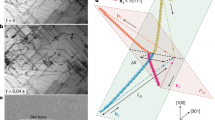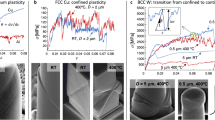Abstract
In situ straining tests in high purity α-Fe thin foils at low temperatures1 have demonstrated that crystal line defects, called dislocations, have a jerky type of motion made of intermittent long jumps of several nanometres. This observation conflicts with the standard Peierls mechanism for plastic deformation in body-centred cubic crystals, where the screw dislocation jumps are limited by inter-reticular distances, that is, distances of a few angstroms. Employing atomic-scale simulations, we show that although the short jumps are initially more favourable, their realization requires the propagation of a kinked profile along the dislocation line, which yields coherent atomic vibrations acting as travelling thermal spikes. Such local heat bursts favour the thermally assisted nucleation of new kinks in the wake of primary ones. The accumulation of new kinks leads to long dislocation jumps like those observed experimentally. Our study constitutes an important step towards predictive atomic-scale theory for materials deformation.
This is a preview of subscription content, access via your institution
Access options
Access Nature and 54 other Nature Portfolio journals
Get Nature+, our best-value online-access subscription
$29.99 / 30 days
cancel any time
Subscribe to this journal
Receive 12 print issues and online access
$259.00 per year
only $21.58 per issue
Buy this article
- Purchase on Springer Link
- Instant access to full article PDF
Prices may be subject to local taxes which are calculated during checkout




Similar content being viewed by others
Data availability
The materials employed for computations and the data that support the findings of the present study are available upon reasonable request from the authors.
Code availability
The numerical codes developed in this work are available upon reasonable request from the corresponding author.
References
Caillard, D. Kinetics of dislocations in pure Fe. Part II. In situ straining experiments at low temperature. Acta Mater. 58, 3504–3515 (2010).
Bulatov, V., Abraham, F. F., Kubin, L., Devincre, B. & Yip, S. Connecting atomistic and mesoscale simulations of crystal plasticity. Nature 391, 669–672 (1998).
Wu, Z. & Curtin, W. A. The origins of high hardening and low ductility in magnesium. Nature 526, 62–67 (2015).
Clouet, E., Caillard, D., Chaari, N., Onimus, F. & Rodney, D. Dislocation locking versus easy glide in titanium and zirconium. Nat. Mater. 14, 931–936 (2015).
Suzuki, T., Takeuchi, S. & Yoshinaga, H. Dislocation Dynamics and Plasticity Ch. 5, 63 (Springer-Verlag, 1991).
Peierls, R. The size of a dislocation. Proc. Phys. Soc. Lond. 52, 34 (1940).
Chamati, H., Papanicolaou, N., Mishin, Y. & Papaconstantopoulos, D. Embedded-atom potential for Fe and its application to self-diffusion on Fe(100). Surf. Sci. 600, 1793 (2006).
Ventelon, L. & Willaime, F. Core structure and Peierls potential of screw dislocations in α-Fe from first principles: cluster versus dipole approaches. J. Comput. Aided Mater. Des. 14, 85–94 (2007).
Chaussidon, J., Fivel, M. & Rodney, D. The glide of screw dislocations in bcc Fe: atomistic static and dynamic simulations. Acta Mater. 54, 3407–3416 (2006).
Proville, L., Rodney, D. & Marinica, M.-C. Quantum effect on thermally activated glide of dislocations. Nat. Mater. 11, 845 (2012).
Benderskii, V., Goldanskii, V. & Makarov, D. Quantum dynamics in low-temperature chemistry. Phys. Rep. 233, 195–339 (1993).
Landeiro Dos Reis, M., Choudhury, A. & Proville, L. Ubiquity of quantum zero-point fluctuations in dislocation glide. Phys. Rev. B 95, 094103 (2017).
Barvinschi, B., Proville, L. & Rodney, D. Quantum Peierls stress of straight and kinked dislocations and effect of non-glide stresses. Model. Simul. Mater. Sci. Eng. 22, 025006 (2014).
Swinburne, T. D. & Marinica, M.-C. Unsupervised calculation of free energy barriers in large crystalline systems. Phys. Rev. Lett. 120, 135503 (2018).
Braun, O. M., Zhang, H., Hu, B. & Tekic, J. Driven kinks in the anharmonic Frenkel-Kontorova model. Phys. Rev. E 67, 066602 (2003).
Scott, A. Encyclopedia of Nonlinear Science, 849 (Routledge, 2005).
Swinburne, T. D., Dudarev, S. L., Fitzgerald, S. P., Gilbert, M. R. & Sutton, A. P. Theory and simulation of the diffusion of kinks on dislocations in bcc metals. Phys. Rev. B 87, 064108 (2013).
Kuramoto, E., Aono, Y. & Kitajima, K. Thermally activated slip deformation between 0.7 and 77 K in high-purity iron single crystals. Philos. Mag. 39, 717 (1979).
Brunner, D. & Diehl, J. Temperature and strain-rate dependence of the tensile flow stress of high-purity α-iron below 250 K II. Stress/temperature regime II and its transitions to regimes I and III. Phys. Status Solidi A 125, 203–216 (1991).
Brunner, D. & Diehl, J. Strain-rate and temperature dependence of the tensile flow stress of high-purity α-iron above 250 K (regime I) studied by means of stress-relaxation tests. Phys. Status Solidi A 124, 155–170 (1991).
Aono, Y., Kitajima, K. & Kuramoto, E. Thermally activated slip deformation of FeNi alloy single crystals in the temperature range of 4.2 K to 300 K. Scr. Metall. 15, 275–279 (1981).
Kitajima, K., Aono, Y., Abe, H. & Kuramoto, E. in Strength of Metals and Alloys (eds Haasen, P. et al.) 965–970 (Pergamon, 1979).
Kuramoto, E., Aono, Y. & Kitajima, K. Thermally activated slip deformation of high-purity iron single crystals between 4.2 and 300 K. Scr. Metall. 13, 1039 (1979).
Lüthi, B., Ventelon, L., Rodney, D. & Willaime, F. Attractive interaction between interstitial solutes and screw dislocations in bcc iron from first principles. Comput. Mater. Sci. 148, 21–26 (2018).
Takeuchi, S., Hashimoto, T. & Maeda, K. Plastic deformation of bcc metal single crystals at very low temperatures. Trans. Jpn Inst. Met. 23, 60–69 (1982).
Hollang, L., Brunner, D. & Seeger, A. Work hardening and flow stress of ultrapure molybdenum single crystals. Mater. Sci. Eng. A 319, 233–236 (2001).
Werner, M. Temperature and strain-rate dependence of the flow stress of ultrapure tantalum single crystals. Phys. Status Solidi A 104, 63–78 (1987).
Nasiri, S. & Zaiser, M. Rupture of graphene sheets with randomly distributed defects. AIMS Mater. Sci. 3, 1340–1349 (2016).
Goryaeva, A. M., Maillet, J.-B. & Marinica, M.-C. Towards better efficiency of interatomic linear machine learning potentials. Computat. Mater. Sci. 166, 200–209 (2019).
Henkelman, G., Uberuaga, B. & Jónsson, H. A climbing image nudged elastic band method for finding saddle points and minimum energy paths. J. Chem. Phys. 113, 9901 (2000).
Gordon, P., Neeraj, T. & Mendelev, M. Screw dislocation mobility in bcc metals: a refined potential description for α-Fe. Philos. Mag. 91, 3931–3945 (2011).
Proville, L. & Rodney, D. Modeling the Thermally Activated Mobility of Dislocations at the Atomic Scale 1525–1544 (Springer International Publishing, Cham, 2020).
Proville, L., Ventelon, L. & Rodney, D. Prediction of the kink-pair formation enthalpy on screw dislocations in α-iron by a line tension model parametrized on empirical potentials and first-principles calculations. Phys. Rev. B 87, 144106 (2013).
Acknowledgements
We gratefully acknowledge D. Caillard and D. Rodney for fruitful discussions.
Author information
Authors and Affiliations
Contributions
Under the supervision of L.P., A.S. realized the MD simulations associated with Fig. 2a,b and Supplementary Figs. 2a,b and 3a,b. L.P. developed the theory, performed the statistical computations and wrote the manuscript and Supplementary Information.
Corresponding author
Ethics declarations
Competing interests
The authors declare no competing interests.
Peer review
Peer review information
Nature Materials thanks the anonymous reviewers for their contribution to the peer review of this work.
Additional information
Publisher’s note Springer Nature remains neutral with regard to jurisdictional claims in published maps and institutional affiliations.
Supplementary information
Supplementary Information
Supplementary Discussion in sections with Figs. 1–9.
Supplementary Video 1
Time evolution of the dislocation profile along the standard Peierls process for a primary kink pair at τyz = 400 MPa and T = 0 K.
Supplementary Video 2
Time evolution of the dislocation profile along the process of macro-kink pair nucleation at τyz = 450 MPa and T = 0 K.
Supplementary Video 3
Time evolution of the dislocation bearing two separated kink pairs at τyz = 450 MPa and T = 0 K.
Rights and permissions
Springer Nature or its licensor (e.g. a society or other partner) holds exclusive rights to this article under a publishing agreement with the author(s) or other rightsholder(s); author self-archiving of the accepted manuscript version of this article is solely governed by the terms of such publishing agreement and applicable law.
About this article
Cite this article
Proville, L., Choudhury, A. Unravelling the jerky glide of dislocations in body-centred cubic crystals. Nat. Mater. 23, 47–51 (2024). https://doi.org/10.1038/s41563-023-01728-5
Received:
Accepted:
Published:
Issue Date:
DOI: https://doi.org/10.1038/s41563-023-01728-5



